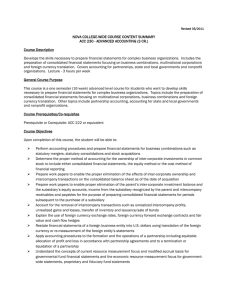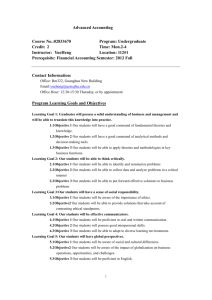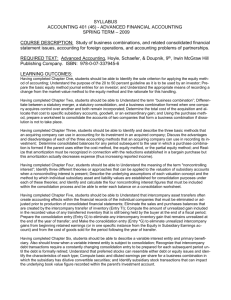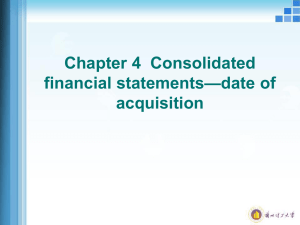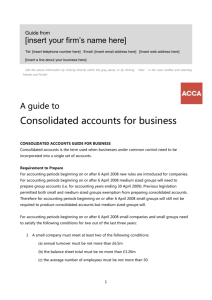ACNT 2333 – Advanced Financial Accounting ed, Jeter/Chaney, Wiley & Sons
advertisement
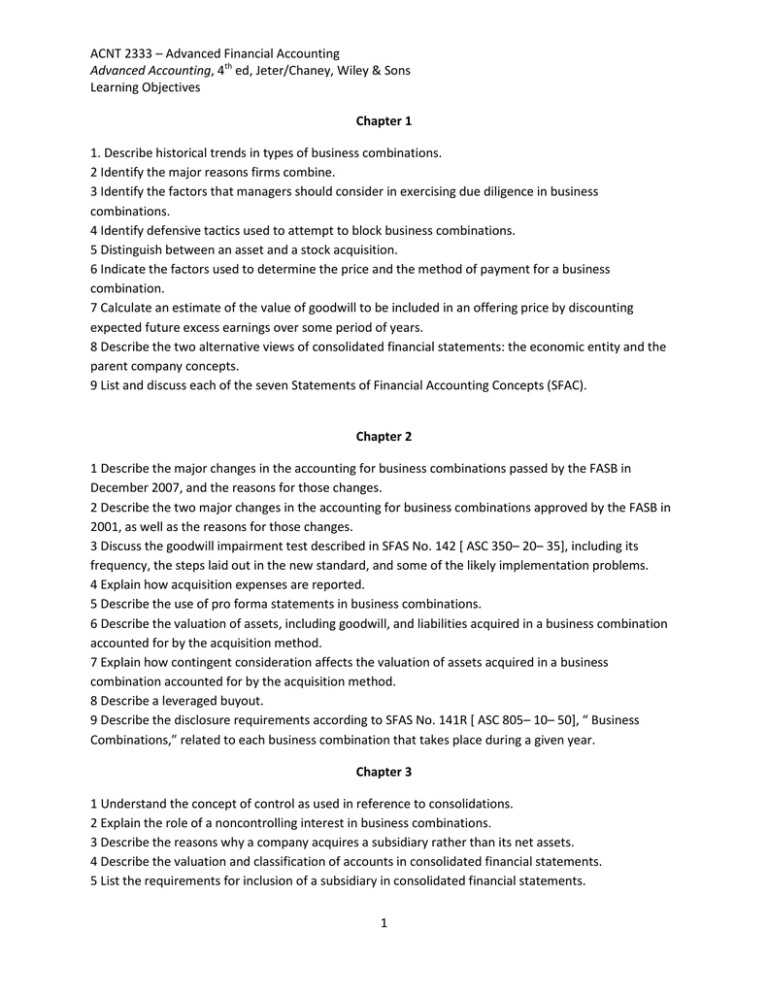
ACNT 2333 – Advanced Financial Accounting Advanced Accounting, 4th ed, Jeter/Chaney, Wiley & Sons Learning Objectives Chapter 1 1. Describe historical trends in types of business combinations. 2 Identify the major reasons firms combine. 3 Identify the factors that managers should consider in exercising due diligence in business combinations. 4 Identify defensive tactics used to attempt to block business combinations. 5 Distinguish between an asset and a stock acquisition. 6 Indicate the factors used to determine the price and the method of payment for a business combination. 7 Calculate an estimate of the value of goodwill to be included in an offering price by discounting expected future excess earnings over some period of years. 8 Describe the two alternative views of consolidated financial statements: the economic entity and the parent company concepts. 9 List and discuss each of the seven Statements of Financial Accounting Concepts (SFAC). Chapter 2 1 Describe the major changes in the accounting for business combinations passed by the FASB in December 2007, and the reasons for those changes. 2 Describe the two major changes in the accounting for business combinations approved by the FASB in 2001, as well as the reasons for those changes. 3 Discuss the goodwill impairment test described in SFAS No. 142 [ ASC 350– 20– 35], including its frequency, the steps laid out in the new standard, and some of the likely implementation problems. 4 Explain how acquisition expenses are reported. 5 Describe the use of pro forma statements in business combinations. 6 Describe the valuation of assets, including goodwill, and liabilities acquired in a business combination accounted for by the acquisition method. 7 Explain how contingent consideration affects the valuation of assets acquired in a business combination accounted for by the acquisition method. 8 Describe a leveraged buyout. 9 Describe the disclosure requirements according to SFAS No. 141R [ ASC 805– 10– 50], “ Business Combinations,” related to each business combination that takes place during a given year. Chapter 3 1 Understand the concept of control as used in reference to consolidations. 2 Explain the role of a noncontrolling interest in business combinations. 3 Describe the reasons why a company acquires a subsidiary rather than its net assets. 4 Describe the valuation and classification of accounts in consolidated financial statements. 5 List the requirements for inclusion of a subsidiary in consolidated financial statements. 1 ACNT 2333 – Advanced Financial Accounting Advanced Accounting, 4th ed, Jeter/Chaney, Wiley & Sons Learning Objectives 6 Discuss the limitations of consolidated financial statements. 7 Record the investment in the subsidiary on the parent’s books at the date of acquisition. 8 Prepare the consolidated workpapers and eliminating entries at the date of acquisition. 9 Compute and allocate the difference between implied value and book value of the acquired firm’s equity. Chapter 4 1 Describe the accounting treatment required under current GAAP for varying levels of influence or control by investors. 2 Prepare journal entries on the parent’s books to account for an investment using the cost method, the partial equity method, and the complete equity method. 3 Understand the use of the workpaper in preparing consolidated financial statements. 4 Prepare a schedule for the computation and allocation of the difference between implied and book values. 5 Prepare the workpaper eliminating entries for the year of acquisition ( and subsequent years) for the cost and equity methods. 6 Describe two alternative methods to account for interim acquisitions of subsidiary stock at the end of the first year. 7 Explain how the consolidated statement of cash flows differs from a single firm’s statement of cash flows. 8 Understand how the reporting of an acquisition on the consolidated statement of cash flows differs when stock is issued rather than cash. Chapter 5 1 Calculate the difference between implied and book values and allocate to the subsidiary’s assets and liabilities. 2 Describe FASB’s position on accounting for bargain acquisitions. 3 Explain how goodwill is measured at the time of the acquisition. 4 Describe how the allocation process differs if less than 100% of the subsidiary is acquired. 5 Record the entries needed on the parent’s books to account for the investment under the three methods: the cost, the partial equity, and the complete equity methods. 6 Prepare workpapers for the year of acquisition and the year( s) subsequent to the acquisition, assuming that the parent accounts for the investment alternatively using the cost, the partial equity, and the complete equity methods. 7 Understand the allocation of the difference between implied and book values to long- term debt components. 8 Explain how to allocate the difference between implied and book values when some assets have fair values below book values. 2 ACNT 2333 – Advanced Financial Accounting Advanced Accounting, 4th ed, Jeter/Chaney, Wiley & Sons Learning Objectives Chapter 6 1 Describe the financial reporting objectives for intercompany sales of inventory. 2 Determine the amount of intercompany profit, if any, to be eliminated from the consolidated statements. 3 Understand the concept of eliminating 100% of intercompany profit not realized in transactions with outsiders, and know the authoritative position. 4 Distinguish between upstream and downstream sales of inventory. 5 Compute the noncontrolling interest in consolidated net income for upstream and downstream sales, when not all the inventory has been sold to outsiders. 6 Prepare consolidated workpapers for firms with upstream and downstream sales using the cost, partial equity, and complete equity methods. Chapter 7 1 Understand the financial reporting objectives in accounting for intercompany sales of nondepreciable assets on the consolidated financial statements 2 State the additional financial reporting objectives in accounting for intercompany sales of depreciable assets on the consolidated financial statements 3 Explain when gains or losses on intercompany sales of depreciable assets should be recognized on a consolidated basis 4 Explain the term “realized through usage” 5 Describe the differences between upstream and downstream sales in determining consolidated net income and the controlling and noncontrolling interests in consolidated income 6 Compare the eliminating entries when the selling affiliate is a subsidiary (less than wholly owned) versus when the selling affiliate is the parent company 7 Compute the noncontrolling interest in consolidated net income when the selling affiliate is a subsidiary 8 Compute consolidated net income considering the effects of intercompany sales of depreciable assets Chapter 11 1 Describe how the changing world environment is leading to an increased focus on international financial reporting standards (IFRS). 2 Explain some of the major differences between IFRS and U. S. GAAP. 3 List the seven milestones that must be achieved before the SEC will require adoption of IFRS. 4 Describe three major joint convergence topics of the IFRS and FASB. 5 List the steps that a non- U. S. company must follow to list its shares on a U. S. stock market. 6 Explain the role of form 20- F filed with the Securities and Exchange Commission. 3 ACNT 2333 – Advanced Financial Accounting Advanced Accounting, 4th ed, Jeter/Chaney, Wiley & Sons Learning Objectives Chapter 12 1 Distinguish between the terms “measured” and “denominated.” 2 Describe what is meant by a foreign currency transaction. 3 Understand some of the more common foreign currency transactions. 4 Identify three stages of concern to accountants for foreign currency transactions, and explain the steps used to translate foreign currency transactions for each stage. 5 Describe a forward exchange contract. 6 Explain the use of forward contracts as a hedge of an unrecognized firm commitment. 7 Identify some of the common situations in which a forward exchange contract can be used as a hedge. 8 Describe a derivative instrument and understand how it may be used as a hedge. 9 Explain how exchange gains and losses are reported for fair value hedges and cash flow hedges. Chapter 13 1 Distinguish between the current exchange rate and the historical exchange rate. 2 Understand the objectives of financial statement translation. 3 Identify the functional currency of a foreign entity. 4 Compare the two methods used to convert the financial statements of a foreign entity into U. S. dollars. 5 Distinguish between the circumstances under which each of the two methods is appropriate under current GAAP. 6 Explain the factors involved in translating the statements of a foreign entity operating in a highly inflationary economy. 7 Translate the statements of a foreign entity when the functional currency is the local currency. 8 Translate the statements of a foreign entity when the functional currency is the U. S. dollar. 9 Understand the concept of comprehensive income in the context of foreign currency translation. 10 Identify the disclosure requirements for firms with foreign entities. Chapter 14 1 Understand the need for disaggregated financial data. 2 Describe the basic requirements of public companies in reporting segmental data. 3 Determine an operating segment. 4 Define a reportable segment. 5 Describe how common costs are handled in segmental reporting. 6 Identify the information to be presented for each reportable segment. 7 Explain when and what types of geographic data must be reported. 8 Explain when information about major customers must be reported. 4

